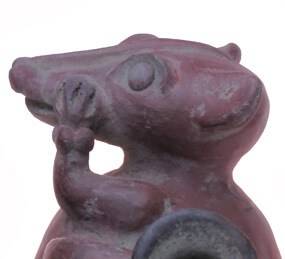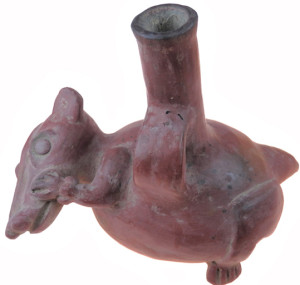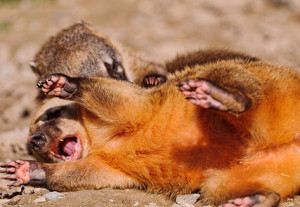
Moche Culture of the northern Peruvian coastline flourished between 100 and 800 AD. With no record of a written language, it is known that they expressed their domestic life, religion and history through their five phases of pottery. The Abbey Museum is very fortunate to have acquired a few pieces of Peruvian zoomorphic pottery. One piece that is a favourite among collection management team members is the Coati cutie [fig.1].

While volunteering on the collection team I was asked to research these effigy vases of Peru, they consisted of a small number of Moche pottery. South America and Meso-American cultures have been an interest of mine since learning about Aztec sacrifices in primary school and so I was very enthusiastic to start.
It was originally suggested that this strange little creature was actually a coyote. However after only after a few hours of research it became evident that it was instead a South American coati (Nasua nasua) [fig.3] identified from an almost identical piece found in an online auction. This conclusion was also supported from coati normal behaviour, as they typically rub their snout and fur as apart of their grooming process [fig. 2].

This was a very exciting discovery and I was very thrilled to be able to contribute something so small as determining the species depicted on the tri-dimensional effigy vase. I was then able to change the official name in the museum records.
It has been suggested that this effigy vessel was used domesticity for carrying liquid. Note the handle (this feature was added so individuals were able to attach it to their belts) and then sometimes the vase was used as a funeral offering. It is interesting to note that the Moche civilization provided offerings at funerals to allow the deceased to continue living in the afterlife, similar to the burials of the Egyptian Pharaohs in approximately 2000 BCE.
Unfortunately this may be one of the last of its kind in such good condition. This unique piece of zoomorphic pottery was created during the rapid expansion of the Moche civilisation in Phase IV (300-800 AD), and after this period the individual settlements started to collapse and the style of pottery changed dramatically to less realistic portraits of their highly celebrated individuals. The Coati vase in the Abbey Museum collection is truly an amazing vase with very unique characteristics.
I’m very excited for when the “Coati” vase will go on display in the museum. It is truly a stunning piece.


